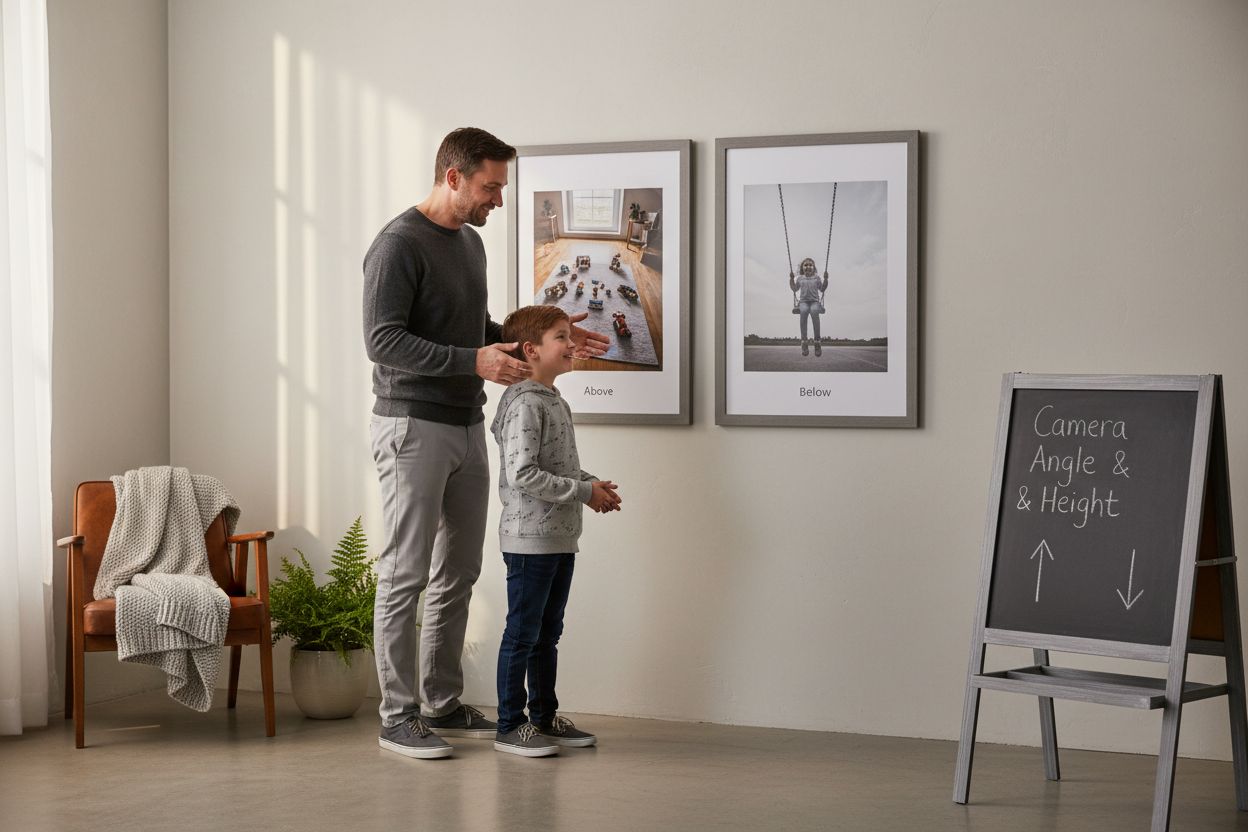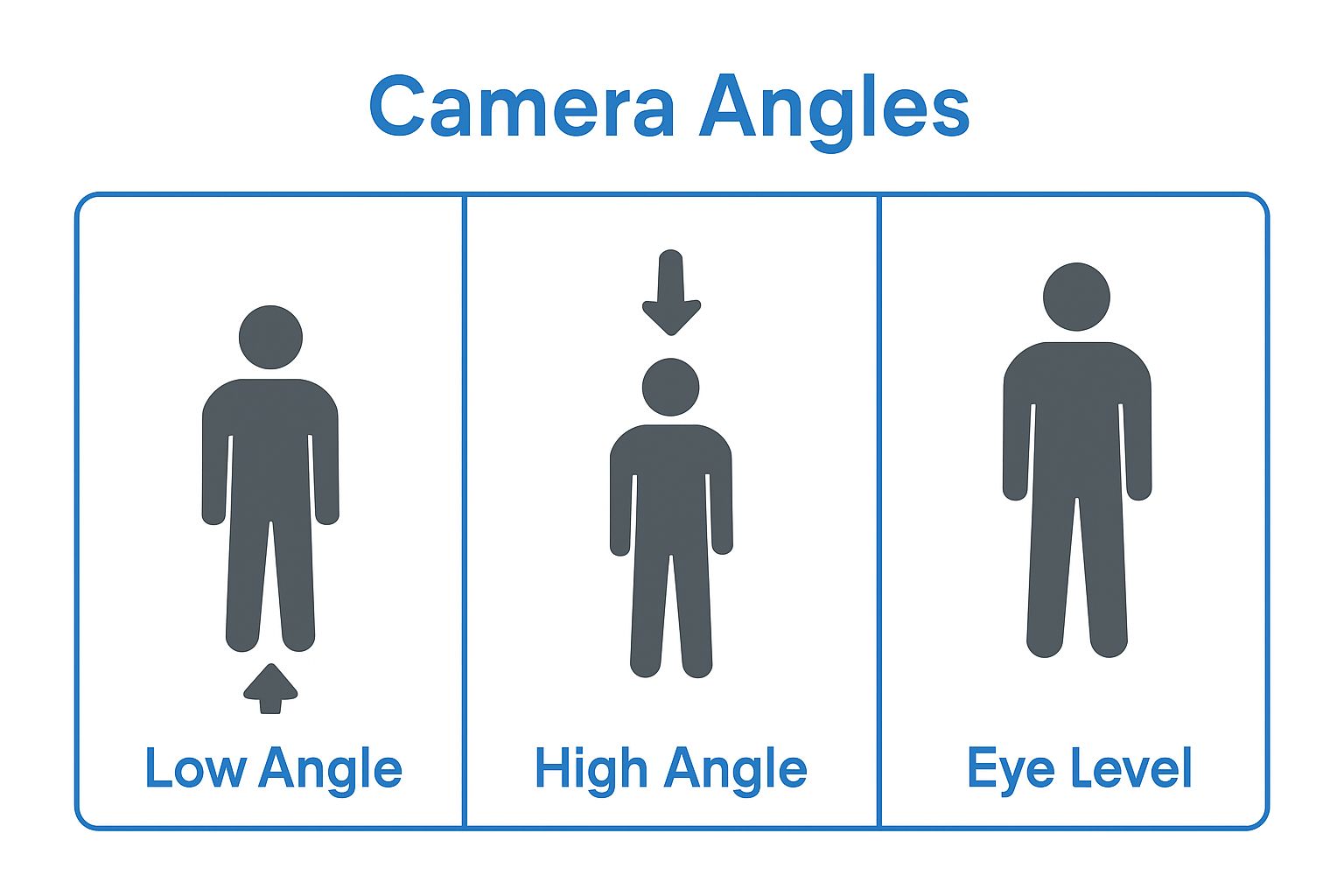Table of Contents
- Table of Contents
- Quick Summary
- Defining Perspective: The Basic Concept in Photography
- The Importance of Perspective: Creating Depth and Emotion
- How Perspective Influences Composition: Framing Your Shot
- Types of Perspective: Exploring Different Viewing Angles
- Real-World Applications: Using Perspective to Enhance Your Photos
- Ready to Transform Your Photos with Powerful Perspective Techniques?
- Frequently Asked Questions
- Recommended
This blog post may contain affiliate links. As an Amazon Associate I earn from qualifying purchases.
Photographic perspective is the magic trick that turns a flat photo into an image bursting with life and emotion. Most people think it is all about snapping what is in front of you, but even tiny changes in camera position can totally shift the mood, story, and impact of your shot. Moving your camera just a few feet can make a subject look powerful or vulnerable and completely change how your audience connects with your photo.
Table of Contents
- Defining Perspective: The Basic Concept In Photography
- The Importance Of Perspective: Creating Depth And Emotion
- How Perspective Influences Composition: Framing Your Shot
- Types Of Perspective: Exploring Different Viewing Angles
- Real-World Applications: Using Perspective To Enhance Your Photos
Quick Summary
| Takeaway | Explanation |
|---|---|
| Perspective shapes viewer perception. | Photographers control how depth and scale are perceived through camera angles and distances. |
| Visual elements create emotional impact. | Camera positioning not only shows subjects but also influences emotional interpretation and narrative mood. |
| Experiment with different viewing angles. | Using various perspectives, like bird’s eye or worm’s eye, changes the story conveyed in an image. |
| Strategic composition enhances narrative. | Arranging visual elements thoughtfully integrates perspective, resulting in compelling visual storytelling. |
| Tailor perspective to photographic genres. | Different genres, such as landscapes or portraits, require unique approaches to perspective for effective communication. |
Defining Perspective: The Basic Concept in Photography
Photographic perspective represents how three-dimensional spatial relationships are translated onto a two-dimensional image surface. At its core, perspective defines how viewers perceive depth, scale, and spatial arrangement within a photographic composition. Understanding perspective allows photographers to dramatically transform visual storytelling and create compelling visual narratives.
The Fundamental Components of Photographic Perspective
Perspective emerges from several key interactions between the photographer, camera, subject, and environment. Camera position plays a crucial role in determining how spatial relationships appear. By changing your physical location relative to subjects, you can significantly alter visual perception.
Three primary factors influence photographic perspective:
- Camera angle and height
- Distance between camera and subject
- Spatial relationships between different objects in the frame
For example, shooting from a low angle can make subjects appear more imposing and powerful, while a high angle can create a sense of vulnerability or diminishment. These subtle shifts fundamentally transform visual storytelling without changing the actual subjects.

Visual Depth and Spatial Relationships
Photographers manipulate perspective to create visual depth through strategic positioning. The human eye naturally perceives depth through multiple visual cues like overlapping elements, relative size, and linear perspective. By understanding these principles, photographers can create images that feel three-dimensional despite being captured on a flat surface.
Interested in exploring more foundational photography concepts? Check out our comprehensive guide on photography basics to deepen your understanding of visual techniques and compositional strategies.
Mastering perspective requires consistent practice and experimentation. Each scene offers unique opportunities to play with spatial relationships, challenging photographers to think creatively about how they frame and capture visual experiences.
The Importance of Perspective: Creating Depth and Emotion
Perspective transcends technical mechanics in photography, serving as a powerful storytelling tool that transforms flat images into immersive visual experiences. Emotional resonance emerges through strategic manipulation of spatial relationships, allowing photographers to guide viewer perception and psychological engagement.
Psychological Impact of Visual Perspective
The way photographers frame subjects profoundly influences emotional interpretation. Different perspectives create distinct psychological responses. Camera positioning acts like a narrative voice, communicating mood, power dynamics, and narrative context without using words.
Key emotional perspectives include:
- Dominant Perspective: Shooting from low angles to make subjects appear powerful or intimidating
- Vulnerable Perspective: High angle shots creating a sense of smallness or weakness
- Intimate Perspective: Close proximity shots revealing intricate details and emotional nuance
For instance, a street photographer capturing a subject from a low angle can transform an ordinary person into a heroic figure, while a high angle might render the same individual seemingly fragile and exposed.
Narrative Depth Through Spatial Relationships
Photographers leverage perspective to construct complex visual narratives. Spatial relationships between objects communicate subtle contextual meanings. The distance between subjects, their relative sizes, and interaction within the frame tell stories more eloquently than words.
Explore our comprehensive guide on street photography techniques to understand how perspective becomes a storytelling mechanism.
Mastering perspective requires understanding human visual perception. By thoughtfully manipulating camera position, photographers transcend mere documentation, creating images that resonate emotionally and intellectually with viewers.
How Perspective Influences Composition: Framing Your Shot
Composition represents the strategic arrangement of visual elements within a photographic frame, with perspective serving as the fundamental language that guides viewer interpretation. Understanding how perspective interacts with compositional principles transforms ordinary images into powerful visual narratives.
The Architectural Elements of Perspective
Perspective acts as the underlying structure that determines how viewers perceive spatial relationships. By consciously manipulating camera position, photographers create complex visual hierarchies that direct attention and communicate meaning. Compositional balance emerges from understanding how different perspectives interact with fundamental design principles.
Critical compositional perspective techniques include:
- Creating visual depth through foreground and background interactions
- Utilizing negative space to emphasize subject significance
- Establishing visual tension through asymmetrical positioning
A landscape photographer might use a low angle to emphasize foreground elements, making distant mountains appear more dramatic and imposing. Similarly, architectural photographers leverage perspective to transform geometric structures into compelling visual statements.
Dynamic Framing and Visual Storytelling
Framing represents the intentional selection of what enters and remains outside the photographic boundary. Perspective determines framing strategies, allowing photographers to control narrative focus and emotional resonance. By shifting camera position mere inches, photographers can dramatically alter subject perception.
Learn advanced framing techniques in our beginner’s photography guide to understand how subtle adjustments transform visual storytelling.
Mastering perspective in composition requires continuous experimentation and a nuanced understanding of visual perception. Photographers must develop an intuitive sense of how spatial relationships communicate complex emotional and narrative experiences.
Types of Perspective: Exploring Different Viewing Angles
Photographic perspective encompasses multiple viewing strategies that fundamentally transform visual storytelling. Viewing angles represent deliberate choices photographers make to communicate specific visual narratives, each approach offering unique emotional and compositional possibilities.
Linear and Aerial Perspective Techniques
Linear perspective describes how photographers use geometric lines and spatial relationships to create depth and dimensionality. This technique relies on converging lines, relative object sizes, and strategic positioning to simulate three-dimensional experiences on two-dimensional surfaces.
Key perspective types include:
- Bird’s Eye View: Overhead shots creating comprehensive spatial understanding
- Worm’s Eye View: Ground-level perspectives offering dramatic, unconventional angles
- Eye-Level Perspective: Natural, intuitive viewpoints mimicking human perception
Each perspective type communicates distinct psychological experiences.
The following table summarizes key types of photographic perspective mentioned in the article, outlining their defining characteristics and the psychological impact each can create for the viewer.
| Perspective Type | Defining Features | Psychological/Visual Effect |
|---|---|---|
| Bird’s Eye View | Shot from high above the subject | Imparts control, overview, sense of detachment |
| Worm’s Eye View | Shot from very low or ground level | Creates drama, sense of vulnerability or power |
| Eye-Level Perspective | Taken at the subject’s natural eye level | Feels natural, relatable, neutral |
| Dominant Perspective | Low angle emphasizing subject size | Makes subject appear powerful or imposing |
| Vulnerable Perspective | High angle diminishing subject size | Conveys weakness or fragility |
| Intimate Perspective | Close distance, capturing emotional details | Enhances emotional connection and immediacy |
| Linear Perspective | Uses converging lines and size changes to show depth | Creates sense of three-dimensionality |
 A bird’s eye view might represent control and comprehensive understanding, while a worm’s eye view suggests vulnerability and unique spatial exploration.
A bird’s eye view might represent control and comprehensive understanding, while a worm’s eye view suggests vulnerability and unique spatial exploration.
Psychological Dimensions of Viewing Angles
Perspective transcends technical mechanics, functioning as a powerful communication tool. Emotional context emerges through intentional camera positioning, allowing photographers to guide viewer interpretation without verbal explanation.
Discover innovative camera techniques for unique perspectives and expand your visual storytelling capabilities.
Understanding perspective requires continuous experimentation and visual curiosity. Photographers must develop an intuitive sense of how different viewing angles transform ordinary scenes into compelling visual narratives.
Real-World Applications: Using Perspective to Enhance Your Photos
Perspective manipulation transforms photography from mere documentation to intentional visual storytelling. Photographers leverage diverse techniques to create images that communicate complex emotional and spatial narratives beyond simple visual representation.
Practical Perspective Strategies in Different Genres
Each photographic genre demands unique perspective approaches. Landscape photographers use foreground elements to create depth, while portrait photographers manipulate camera angles to reveal subject personality. Strategic positioning allows photographers to control viewer perception and emotional engagement.
Critical perspective application techniques include:
- Architectural photography utilizing geometric lines and symmetry
- Landscape photography emphasizing depth through foreground layering
- Portrait photography exploring emotional nuance through angle selection
A street photographer might crouch low to make a pedestrian appear heroic, or shoot from an elevated position to capture urban complexity. These intentional perspective choices transform ordinary scenes into compelling visual narratives.
This table breaks down major photographic genres discussed in the article and highlights how manipulating perspective is uniquely applied within each to achieve specific visual and emotional outcomes.
| Photographic Genre | Perspective Strategy Used | Intended Visual/Emotional Effect |
|---|---|---|
| Landscape Photography | Foreground layering, low angles | Creates depth, makes distant elements dramatic |
| Portrait Photography | Angle selection (high/low), proximity | Reveals personality, conveys emotion |
| Architectural Photography | Use of geometric lines and symmetry | Highlights structure, emphasizes space |
| Street Photography | Low/high shooting stances, active repositioning | Alters subject narrative, suggests heroism/vulnerability |
Technical and Emotional Perspective Considerations
Successful perspective application requires understanding both technical mechanics and emotional communication. Camera positioning becomes a sophisticated language, communicating mood, power dynamics, and narrative context without verbal explanation.
Enhance your post-processing skills to complement perspective techniques and refine your visual storytelling approach.
Mastering perspective demands continuous experimentation, technical understanding, and creative intuition. Photographers must develop a nuanced ability to see beyond immediate visual information, transforming spatial relationships into powerful emotional experiences.
Ready to Transform Your Photos with Powerful Perspective Techniques?
Mastering perspective is a challenge for many beginner photographers. You might struggle to make your images feel dynamic or fail to convey the depth and emotion you envision. This article explained how the right camera positioning and viewing angles can help you create photos that truly stand out. If you are looking to overcome flat, lifeless shots and want to unlock the secrets behind compelling depth, our resources are tailored for you.

Start elevating your photography by exploring practical shooting tips and guides designed for hobbyists like you. Dive deeper with our hands-on articles covering camera angles, composition tricks, and visual storytelling strategies. Visit Amateur Photographer Guide now to find step-by-step tutorials and expert recommendations. Take the next step today and give your photos the depth and narrative strength you have been missing.
Frequently Asked Questions
What is perspective in photography?
Perspective in photography refers to the way three-dimensional relationships are represented in a two-dimensional image. It impacts how viewers perceive depth, scale, and arrangement. To understand perspective better, practice taking photos from different angles to see how it alters the image’s emotional impact.
How does camera position affect perspective?
Camera position is crucial for determining the appearance of spatial relationships in your photos. By changing your distance and angle relative to your subject, you can create different moods or emphasize certain characteristics. Experiment with shooting from low and high angles to observe how it influences your subject’s portrayal.
What are the different types of perspective techniques in photography?
Common types of perspective techniques include linear perspective, bird’s eye view, worm’s eye view, and eye-level perspective. Each technique offers unique emotional effects and spatial representations. Choose one technique for your next photo to practice conveying a specific narrative.
How can I create visual depth in my photographs?
You can create visual depth in your images by strategically positioning foreground and background elements. Use overlapping objects, varying sizes, and leading lines to enhance the sense of three-dimensionality. Try incorporating contrasting elements within your next five photos to see how depth changes the overall composition.
Why is perspective important for storytelling in photography?
Perspective is essential for visual storytelling, as it helps convey emotional context and narrative dynamics without words. By carefully considering how you frame your shots, you can evoke specific feelings in viewers. Make a conscious choice about perspective the next time you plan a shoot to enhance your narrative impact.
How can I improve my understanding of perspective in photography?
Improving your understanding of perspective involves regular practice and experimentation. Take time to analyze the spatial relationships in your favorite images and attempt to recreate them. Set a goal to take at least three experimental shots each week, focusing on different perspectives.

